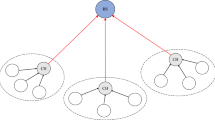Abstract
The mobile ad hoc network (MANET) has attracted a lot of interest recently. However, most of the existing works have assumed a stand-alone MANET. In this paper, we propose a two-tier, heterogeneous MANET architecture which can support Internet access. The low tier of the network consists of a set of mobile hosts each equipped with a IEEE 802.11 wireless LAN card. In order to connect to the Internet and handle the network partitioning problem, we propose that the high tier is comprised of a subset of the mobile hosts, called gateways, which can access to cellular/infrastructure networks. The high tier is heterogeneous in the sense that the network interfaces in the gateway hosts could be IEEE 802.11 cards, PHS handsets, or GPRS handsets characterized by different bandwidths and latencies. Observing that the gateways could become the bottlenecks of the two-tier network, we propose a set of solutions, namely boundary-moving, host-partitioning, and probabilistic solutions, to solve the load-balance routing issue. Implementation issues/concerns of these schemes are discussed. Simulation results are presented to compare these load-balance routing schemes.
Similar content being viewed by others
References
F. Aurenhammer, Voronoi diagrams: A survey of a fundamental geometric data structure, ACM Computing Surveys 23(3) (September 1991) 345–405.
T.H. Cormen, C.E. Leiserson and R.L. Rivest, Introduction to Algorithms (MIT Press, Cambridge, England, 1994).
M.R. Garey and D.S. Johnson, Computers and Intractability. A Guide to the Theory of NP-Completeness (Freeman, New York, 1979).
D.B. Johnson and D.A. Maltz, Dynamic Source Routing in Ad Hoc Wireless Networks, Vol. 353, Chapter 5 (Kluwer Academic Publishers, 1996) pp. 153–181.
Y.-D. Lin and Y.-C. Hsu, Multihop cellular: A new architecture for wireless communications, in: Proceedings of the 19th Annual Joint Conference of the IEEE Computer and Communications Societies (INFOCOM 2000) pp. 1273–1282.
S. Lu, V. Bharghavan and R. Srikant, Fair scheduling in wireless packet networks, IEEE/ACM Transactions on Networking 7(4) (August 1999) 373–389.
J.P. Macker and M.S. Corson, Mobile ad hoc networking and the IETF, ACM Mobile Computing and Communications Reviews 4(4) (October 2000) 12–13.
R.E. Miller and J.W. Thatcher (eds.), Complexity of Computer Computations (Plenum Press, New York, 1972).
A.K. Parekh and R.G. Gallager, A generalized processor sharing approach to flow control in integrated services networks: The single node case, IEEE/ACM Transactions on Networking 1(3) (June 1993) 344–357.
C.E. Perkins, Mobile IP Design Principles and Practices (Addison-Wesley, Boston, MA, 1997).
C.E. Perkins, Ad Hoc Networking (Addison-Wesley, Boston, MA, 2001).
C.E. Perkins, Mobile IP, IEEE Communication Magazine 40(5) (May 2002) 66–82.
C.E. Perkins and P. Bhagwat, Highly dynamic destination-sequenced distance-vector routing (DSDV) for mobile computers, in: Proc. of the ACM SIGCOMM Conference on Communications Architectures, Protocols and Applications (1994) pp. 234–244.
C.E. Perkins and E.M. Royer, Ad hoc on-demand distance vector routing, in: Proc. of the 2nd IEEE Workshop on Mobile Computing Systems and Applications (February 1999).
C.E. Perkins, E.M. Royer, S.R. Das and M.K. Marina, Performance comparison of two on-demand routing protocols for ad hoc networks, IEEE Personal Communications 8(1) (February 2001).
J.B. Postel (ed.), Internet Protocol, Internet Request for Comments RFC 791 (September 1981).
E.M. Royer and C.-K. Toh, A review of current routing protocols for ad hoc mobile wireless networks, IEEE Personal Communications 6(2) (April 1999) 46–55.
D. Stiliadis and A. Varma, Efficient fair queueing algorithms for packet-switched networks, IEEE/ACM Transactions on Networking 6(2) (April 1998) 175–185.
S.A. Thomas, IPng and the TCP/IP Protocols, Chapter 4 (Wiley, New York, 1996) pp. 113–117.
Y.-C. Tseng and T.-Y. Hsieh, Fully power-aware and location-aware protocols for wireless multi-hop ad hoc networks, in: Proc. of the Int'l Conf. on Computer Communication and Networks (ICCCN) (2002).
Y.-C. Tseng, C.-C. Shen and W.-T. Chen, Mobile IP and ad hoc networks: An integration and implementation experience, IEEE Computer 36(5) (May 2003) 48–55.
H. Wu, C. Qiao, S. De and O. Tonguz, Integrated cellular and ad hoc relaying systems: iCAR, IEEE Journal on Selected Areas in Communications 19(10) (October 2001) 2105–2115.
I.-W. Wu, W.-S. Chen, H.-E. Liao and F.-F. Young, A seamless handoff approach of mobile IP protocol for mobile wireless data networks, IEEE Transactions on Consumer Electronics 48(2) (May 2002) 335–344.
Author information
Authors and Affiliations
Rights and permissions
About this article
Cite this article
Huang, CF., Lee, HW. & Tseng, YC. A Two-Tier Heterogeneous Mobile Ad Hoc Network Architecture and Its Load-Balance Routing Problem. Mobile Networks and Applications 9, 379–391 (2004). https://doi.org/10.1023/B:MONE.0000031605.84447.1d
Issue Date:
DOI: https://doi.org/10.1023/B:MONE.0000031605.84447.1d




